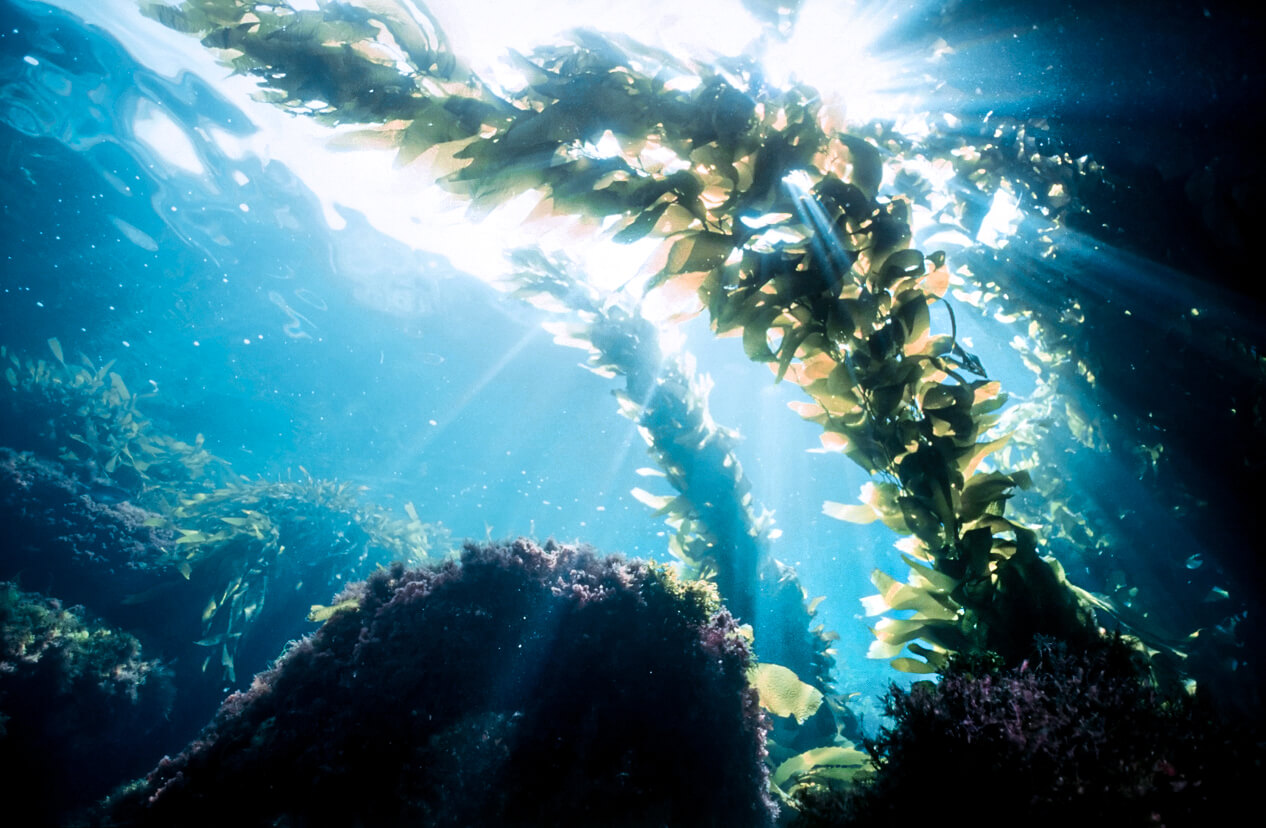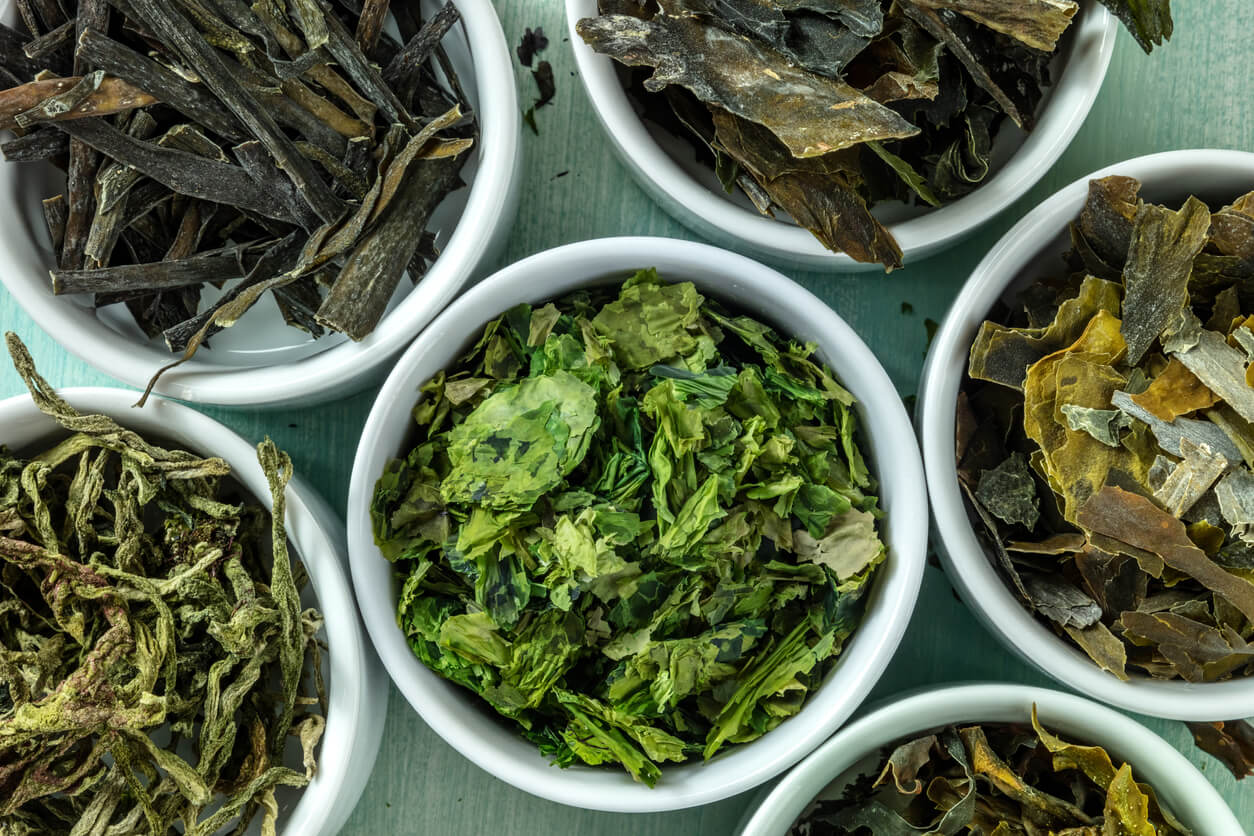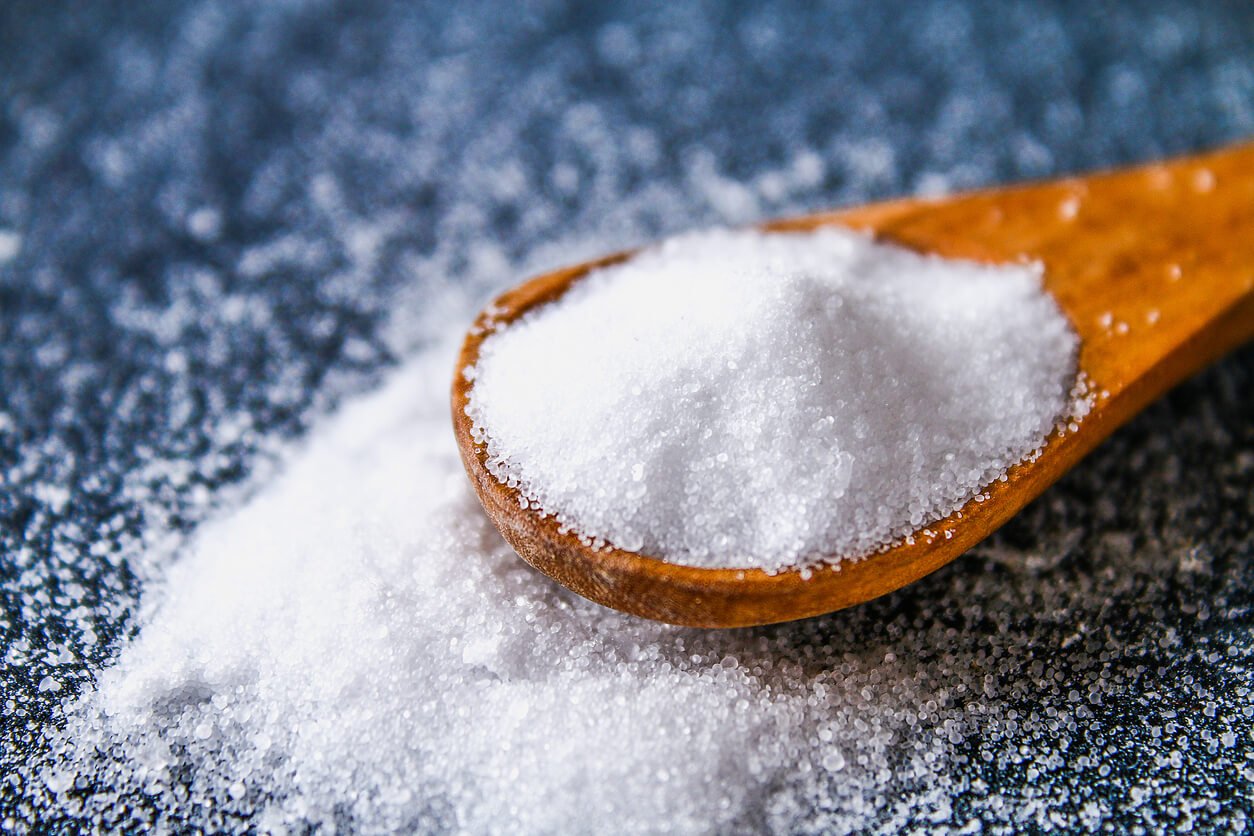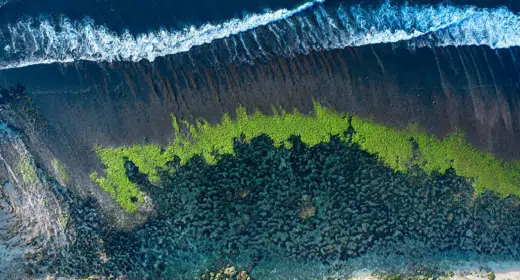by Ocean Robbins: The comedian Steven Wright once said, “I have a large sea shell collection which I keep scattered on beaches all over the world. Maybe you’ve seen it…”
If the beaches are a sea shell museum, then the sea plants that wash up on shores must constitute the vegan option in the museum’s cafe. Popularly known as seaweed, and recently rebranded as sea vegetables (which are technically the portion of all the seaweeds that are edible to humans, though we’ll use the terms a bit interchangeably in this article), these marine plants are poised to become, in the eyes of culinary trendspotters, the “new kale.”
And why not? They’ve got all the buzzwords going for them: organic, regenerative, non-GMO. And they’re versatile: from sushi to roasted seaweed snacks to smoothie ingredients, more and more people throughout the world are eating a wide variety of sea veggies.
While sea vegetables have long been a staple in Asian cultures, until recently, they’ve been largely absent from western cuisine. Only with the rise in popularity of sushi have they made their way into prominence on the world stage. And still, there’s a big gap between daintily nibbling on rice and veggies wrapped in nori, and viewing mounds of seaweed washed up on a beach and thinking, “Oh, yum!”
But that’s changing, and rapidly. Seaweeds — or as they’re often called, sea vegetables — now have some marketing muscle behind them. And there’s a lot to market; many varieties offer intriguing health benefits and may even be associated with increased longevity. Case in point, the centenarians living in the Blue Zone region of Okinawa, Japan, regularly incorporate sea vegetables into their diet.
But despite their benefits to both our health and the environment, there are some potential downsides to consider on both fronts.
So what’s the deal with sea vegetables? Are they good for you or the environment? Where do you find them? And, what are the best ways to use them in your diet?
What Are Sea Vegetables?

In most cases, sea vegetables are actually edible marine algae, or macroalgae. This is different from freshwater algae, like chlorella or spirulina (which also have great health benefits!). The macroalgae are plant-like organisms that generally live attached to rock or other hard surfaces in coastal areas. They have no true roots or leaves, and are more similar to mushrooms or lichen than terrestrial plants. But just like terrestrial plants, sea vegetables use photosynthesis to convert sunlight into energy.
Since the mid-19th century, cooks have categorized sea vegetables by color: green, brown, or red.
There are several popular types of sea vegetables:
Nori
Most commonly known for its use in rolling sushi, nori is a dried, pressed red seaweed. It has a naturally salty, umami flavor and is low in calories and high in minerals like vitamins B12, A, and C, along with iodine, magnesium, calcium, iron, and potassium.
Dulse
You can find dulse — a red sea veggie — in dried flake form, which you can shake onto other prepared dishes like pasta, stir-fries, and casseroles.
Arame
More of a garnish than an actual dish, arame is a brown seaweed served in long, thin strands, often as part of a Japanese-inspired salad. With a slightly sweet flavor, it is high in fiber, calcium, iodine, iron, magnesium, and vitamin A. When sold, arame can be found shredded, cooked, and air-dried and can be reconstituted with water. You can steam it, sauté it, or add it to hot soup.
Kombu
Unlike other types of seaweed, kombu can be used to make an umami soup stock called dashi, which is the foundational flavor of Japanese cuisine. You can also use kombu in dishes to impart a crunchy, firm texture or as a soft and pliable addition. Kombu is rich in calcium and contains more iodine than other seaweeds. This brown sea vegetable is also beloved for its ability to increase the digestibility of beans (making the “musical fruit” less musical). Thanks to its versatility and ubiquity in Japanese cooking, kombu has earned the nickname “king of seaweeds.”
Wakame
Frequently used in Asian dishes like salads, soups, and snacks, wakame also gets used as a seasoning. It’s sometimes known as “sea mustard,” referring to its visual resemblance to mustard greens when cooked. Not surprisingly, it’s a very good source of calcium, iron, riboflavin, folate, and magnesium.
Wakame has a mild flavor and generally comes either dried or salted and fresh in the refrigerated section. If purchased dried, wakame has to be reconstituted by soaking in water for five to six minutes before using. Rehydrated, wakame has a slippery, rubbery, almost squeaky texture. (Maybe one day it will replace plastic in the rubber duck industry!)
Other Less Common Sea Vegetables

Less commonly consumed outside of Asia are sea moss, sea grapes, and sea beans. While not exactly seaweeds, these are also classified as sea vegetables.
- Sea moss (Chondrus crispus) is also called Irish moss, and often gets sold as a dietary supplement in powdered form. The red algae are also the main source of carrageenan — a polysaccharide used to thicken some foods and beverages (You can read about carrageenan concerns here).
- Sea grapes, or umibudo, come from southeast Asia (not to be confused with the seagrape tree native to the Caribbean). If you don’t live within driving distance of one of the villages where they’re grown, you’ll have to order the dried version online. These sea veggies look like tiny bunches of grapes on strands, and deliver a satisfying, crunchy texture and pop when you bite into them. However, unlike regular grapes, sea grapes taste like the ocean and are more salty than sweet.
- Sea beans, or salicornia, may look more like a fish tank decoration, but can be found at many farmers markets in the summer if you live near the shore. Sometimes called “sea asparagus,” sea beans are often used in crunchy salads, as a garnish, or in chickpea frittatas.
Nutrition of Sea Vegetables

So are sea vegetables healthy? Well, they’re packed with nutrients, but are more appropriate as a garnish rather than something to pile on your plate every day. In fact, even in Japan — where sea vegetables are more common — people typically don’t eat them daily.
Sea vegetables are such a rich source of many micronutrients that it doesn’t take much to meet or even exceed our daily requirements for those nutrients. That’s why moderation is key, to keep you from getting way more of certain nutrients than is actually healthy.
Most types of sea vegetables are good sources of protein, fiber, healthy polyunsaturated fats, antioxidants, minerals, and vitamins. Some of the most concentrated minerals in sea vegetables are iodine, sodium, magnesium, and calcium. They’re also rich in B vitamins like folate and vitamin B12, as well as vitamins A, D, and K1.
Certain types of marine algae can even be made into algal oil, a vegan source of the very important omega-3 fatty acids EPA and DHA.
In one sheet of nori, for instance, you’ll get around 10 calories, 0 grams of fat, one gram of protein, one gram of carbs, one gram of fiber, six percent of the Daily Value (DV) for vitamin A, and four percent of the DV for vitamin C. It also has B vitamins, manganese, iron, and omega-3 fatty acids. One sheet also provides around 11% of the DV for iodine, which could be health bringing, or not, as you’ll soon see.
While different varieties of seaweed contain similar nutrient types, the amounts can vary greatly by species and preparation method. For instance, while 100 grams of dulse contains 307 mg of sodium, 100 grams of rockweed contains over 4,000 mg (more than the average American eats in an entire day)!
7 Health Benefits of Sea Vegetables

Sea vegetables, rich as they are in so many important nutrients, offer a number of health benefits.
1. May support thyroid health
Sea vegetables are the second richest source of iodine, after iodized salt. Iodine is an essential mineral, needed to make thyroid hormones that control your metabolism as well as other important functions for health. Many healthy, plant-based foods contain compounds that can interfere with iodine uptake, making it all the more important to get iodine from reliable sources, like iodized salt and/or small amounts of sea vegetables like dulse, kelp, and wakame.
2. May support pregnancy and postpartum recovery
The recommended daily intake of iodine during pregnancy is 220 micrograms to both meet the mother’s needs and pass on the nutrient to the baby. But many pregnant women don’t get this much. Families in Korea often make seaweed soup, or “miyeok guk,” for new moms to aid in postpartum recovery. It’s intended to provide nutrients like iodine for a baby’s brain development, iron to prevent anemia, calcium to prevent bone loss, and fiber to prevent constipation, among an array of other benefits.
3. May offer anticancer benefits
Sea vegetables may inhibit cancer cell growth and offer therapeutic benefits in the treatment of liver cancer. Red seaweeds contain compounds called porphyran and carrageenan that may help protect against cancer by boosting immunity and promoting cancer cell death.
Other types of seaweeds also contain anticancer compounds like terpenes, polyphenols, phlorotannins, fucoidans, and polysaccharides, which can help defend cells against environmental stressors that may lead to cancer. A 2014 review published in the journal Marine Drugs discusses how bioactive compounds in seaweed may offer therapeutic effects in cases of breast and colorectal cancers, primarily by inducing cancer cell death in both lab and human studies.
4. May support heart health
Sea vegetables are rich in dietary fibers, polyphenols, peptides, phlorotannins, lipids, and minerals, which may have a role in both preventing and treating cardiovascular diseases. Seaweeds are rich in antioxidants, which can help protect cells from oxidative damage that leads to heart disease. Other compounds in them may promote blood vessel dilation, which can bring down high blood pressure.
Additionally, sea vegetables contain flavonoids that may have beneficial metabolic effects on obesity and atherosclerosis, which are two risk factors for heart disease. Still other research has observed the ability of seaweed compounds to help lower blood fats, like total cholesterol, LDL “bad” cholesterol, and triglycerides.
5. May have antiviral benefits
Brown seaweed contains compounds called sulfoquinovosildiacylglycerols (which, sadly, is two syllables short of supercalifragilisticexpialidocious, so that particular mnemonic melody won’t help you remember it) — mercifully abbreviated to SQDGs — that have been found to have antiviral properties, particularly when it comes to herpes simplex viruses or cold sores. Many types of marine algae contain structural sulfated polysaccharides, which inhibit viral replication early in the process, preventing these viruses from attaching to a host (in other words, us).
6. May protect against obesity-associated metabolic complications
Sea vegetables are a rich source of compounds that appear to support a number of metabolic functions. A 2020 study published in the journal Current Developments in Nutrition examined the effects of Pacific dulse (a red algae) and wakame (a brown algae) on metabolic complications in obese mice. (Our view on the use of animals in medical research is here.) The authors found that even when fed a high-fat diet, the mice who were fed sea vegetables excreted more fat, experienced less systemic inflammation, and had healthier gut microbiomes compared to mice who did not eat them.
7. May protect gut health
Research shows that disturbances in the gut microbiome can underlie many chronic diseases, including type 2 diabetes, heart disease, gastrointestinal disorders, and cancers. To help prevent these changes, prebiotics are often recommended to promote an optimal balance of good gut bacteria. Compounds in seaweed, such as polyphenols, polyunsaturated fatty acids, and carotenoids, may help break down polysaccharides and oligosaccharides, and promote prebiotic activity in the gut that helps to reduce occurrence of chronic diseases.
5 Health Concerns Associated with Sea Vegetables

Despite their many benefits for your health, sea vegetables also come with potential downsides to consider before adding them to your diet.
1. May contribute too much iodine
As mentioned, sea vegetables are a rich source of iodine. And while iodine is an essential nutrient, there is such a thing as getting too much of it, which can be easy to do if you’re eating a lot of sea vegetables daily. Too much iodine can lead to hyperthyroidism and can also interfere with thyroid medications, like Synthroid.
In fact, some species of kelp (such as kombu) are generally not recommended because their iodine content is so high. The recommended average daily intake of iodine is 150 mcg/day for non-pregnant, non-breastfeeding adults. And most people may want to stay below an average of 300 mcg/day on a day-to-day basis, and definitely below 1,100 mcg/day, which is the daily tolerable upper limit for people without thyroid disease. Since a single tablespoon of dried kelp may contain up to 2,000 mcg of iodine, even modest amounts of this sea vegetable on a regular basis could cause problems.

















































